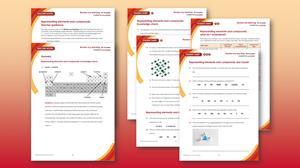Review your learners’ understanding of key ideas, words and phrases relating to representing elements and compounds
This resource features three different versions of a worksheet on representing elements and compounds: scaffolded, partially scaffolded and unscaffolded. Use the worksheets to identify learners’ knowledge gaps and misconceptions once you have taught this part of the curriculum. Find out more about how to use this resource or download the worksheets below.
-

Download this
Download the scaffolded, partially scaffolded and unscaffolded student worksheets.
You will find model answers in the teacher guidance.
View and download more Review my learning worksheets
Curriculum topics
These worksheets cover the following topics:
- chemical symbols
- chemical formulas of elements
- chemical formulas of simple molecular compounds
- empirical formulas of ionic compounds
- the use of models to represent elements and compounds
- the chemical formula of a polymer
- comparing different types of representation.
How to use this resource
The worksheets can be used in a variety of ways:
- to assess learners’ knowledge at the beginning or end of a period of teaching. Match the level of the worksheet to the support needs of the learners;
- to assess knowledge during a period of teaching once learners have completed the relevant topic;
- as part of revision;
- as a refresher exercise for teachers or non-subject specialists.
Scaffolding
Three levels of support, provide options depending on the diverse support needs of learners. An editable version of each worksheet provides further opportunities to adapt the resources to meet individual learning needs. There is also scope to increase the level of the worksheets used, as learners progress through their curriculum.
Independent learning and metacognition
The ‘What do I understand?’ page is common to all worksheets. Learners are encouraged to develop independent learning skills and can use their reflection as a guide for revision. The feedback will also help you to identify areas where a whole class needs attention.
Answers
The teacher guidance provides model answers for all questions, plus guidance on learners’ common misconceptions. Learners can use the model answers to peer or self-assess.
More resources
- Read the Teaching science skills article on models from Education in Chemistry and use the teacher notes, PowerPoint slides and student worksheet to interpret and evaluate models.
- Display the periodic table poster in your classroom and download the resource to organise unknown elements using their similarities, physical properties, appearances and reactivities.
- Clear up misconceptions when teaching ionic and covalent bonding at 14–16 with these CPD articles.
- Watch the video job profile to show learners how science communicators like Fernando use their scientific knowledge to uncover and translate chemistry for the public.
- Use the bonding workshop to explore simple covalent molecules and hydrocarbons with a series of activities perfect for a sequence of timetabled lessons, science clubs or during an activity day.
Downloads
Representing elements and compounds scaffolded student worksheet
Handout | PDF, Size 0.67 mbRepresenting elements and compounds partially scaffolded student worksheet
Handout | PDF, Size 0.67 mbRepresenting elements and compounds unscaffolded student worksheet
Handout | PDF, Size 0.5 mbRepresenting elements and compounds teacher guidance and answers
Handout | PDF, Size 0.32 mbRepresenting elements and compounds scaffolded student worksheet
Editable handout | Word, Size 0.39 mbRepresenting elements and compounds partially scaffolded student worksheet
Editable handout | Word, Size 0.37 mbRepresenting elements and compounds unscaffolded student worksheet
Editable handout | Word, Size 0.34 mbRepresenting elements and compounds teacher guidance and answers
Editable handout | Word, Size 0.19 mb


















No comments yet